Abstract
Several room acoustic parameters have to be considered in ordinary public rooms, such as offices and classrooms, in order to present the actual conditions, thus increasing demands on the acoustic treatment. The most common acoustical treatment in ordinary rooms is a suspended absorbent ceiling. Due to the non-uniform distribution of the absorbent material, the classical diffuse field assumption is not fulfilled in such cases. Further, the sound scattering effect of non-absorbing objects such as furniture are considerable in these types of rooms. Even the directional characteristic of the sound scattering objects are of importance. The sound decay curve in rooms with absorbent ceilings often demonstrate a double slope. Thus, it is not possible to use reverberation time as room parameter as a representative standalone acoustic measure. An evaluation that captures the true room acoustical conditions therefore needs supplementary parameters. The aim of this experimental study is to show how various acoustical treatments affect reverberation time T20, speech clarity C50 and sound strength G. The experiment was performed in a mock-up of a classroom. The results demonstrated how absorbers, diffusers and scattering objects influence room acoustical parameters. It is shown that to some extent the parameters can be adjusted individually by using different treatments or combination of treatments. This allows for the fine-tuning of the acoustical conditions, in order to fulfill the requirements for achieving a high-quality sound environment.
1. Introduction
In ordinary public rooms, the typical acoustic treatment is a suspended absorbent ceiling. Examples of ordinary public rooms are classrooms, offices, health care premises and restaurants. Many people spend their working days in those spaces performing a variety of different activities. The acoustical conditions are crucial for people’s wellbeing and while supporting their activities.
1.1. Room Acoustic Parameters in Classrooms
The importance of good acoustical conditions in schools, with classrooms that support speech communication, as well as concentrated work, is well documented. Several surveys in school environments have emphasized the detrimental effects of insufficient acoustic treatment in classrooms [1,2]. The effect on cognitive functions, such as working memory, have been investigated [3], as well as on academic attainment [4]. Acoustical treatment in classrooms should not only secure good listening conditions; it has been reported that teachers suffer from voice disorders to a greater degree than the rest of the population [5]. Objective measures for voice support in medium-sized classrooms have therefore been developed [6,7,8].
The most common way to specify room acoustical target values in standards and regulations is to use reverberation time T60 [9]. The reverberation time is often evaluated as T20, i.e., evaluating the range −5 to −25 dB of the decay curve. Validation is defined in ISO 3382-2 [10]. Due to the procedure for evaluation of T20, early reflections are ignored. As stated in textbooks on acoustics [11,12], it is known that two rooms with the same reverberation time can still be perceived as different, and that the reverberation is not solely enough to characterize room acoustical conditions. The fact that early reflections are ignored in evaluating T20 is a plausible explanation for the occasionally bad correlation between the perceived condition. Furthermore, in rooms with ceiling treatment, the decay curve is often double-sloped, with a steep slope at the start of the decay and a less steep slope towards the end of the decay [13]. Thus, there is an ambiguity in the evaluation of the reverberation time, due to the non-linear behavior of the decay curve. Consequently, complementary room acoustic parameters are needed, in order to capture the subjective experience of the acoustical conditions.
Lochner and Burger [14] emphasized the importance of early reflections for the subjective impression of an auditorium, stating that it is the sound field and pattern of reflections that will affect how the sound environment is experienced, rather than one single parameter. The early reflections will contribute to the direct sound and thereby to the clarity of speech. The importance of parameters including early reflections, such as speech clarity C50, have also been investigated in several studies [15,16,17,18,19,20]. Another parameter for speech intelligibility is the Speech Transmission Index (STI). The parameters C50 and STI have been introduced in some national standards [21,22]. STI is defined in IEC60268-16 [23] and C50 in ISO 3382-1 [24]. C50 is an energy ratio for early-to-late arriving energy expressed in dB. The time limit between early and late energy is set at 50 ms for speech. Another parameter describing the relation between early and late reflections is definition, D50, which is expressed as a percentage. These two parameters, C50 and D50, are exactly related. In this study C50 has been investigated.
In a recent study [25], the reading speed for Italian second graders was investigated. The study indicates a relation between reading speed and C50. No correlation to reverberation time was identified.
Bradley et al. [26] investigated speech intelligibility in classrooms, examining the relation between signal-to-noise ratio and room acoustic parameters. The results from [26] show that the effect on signal-to-noise ratio is very important for speech intelligibility, and useful-to-detrimental ratios are proposed and recommended, instead of only focusing on the reverberation time. Further, they concluded that an increase in early reflections could improve signal-to-noise ratio by up to 9 dB [27].
The non-linear decay curve in a room with absorbent ceiling treatment also implies that there is a difference in the character of the sound field at steady-state and during the latter part of the decay. It is therefore also of interest to use the parameter sound strength G defined in ISO 3382-1. This parameter is measured during steady state, and relates to how sound reflections in a room contribute to the sound pressure level. Sound strength has mainly been used for concert halls and other performance spaces [28,29], but also for the evaluation of acoustical conditions in classrooms [15].
1.2. Room Acoustic Treatment in Classrooms
The most common acoustic treatment in ordinary public rooms is a sound absorbent ceiling and traditionally, as mentioned above, the required target values are defined by the reverberation time. When most of the absorption in ordinary rooms is predominately located at the ceiling, the scattering properties of furniture and other interior equipment will affect the acoustical conditions [30]. In fact, even the directional characteristics of sound scattering objects in a room with a suspended absorbent ceiling will be significant. If the sound scattering objects redirect the energy up onto the absorbent ceiling or in a direction towards other sound reflecting surfaces, such as walls, the outcome will be different. This circumstance also presents the possibility of using sound scattering objects in order to fine tune acoustical conditions. Diffusers have long been used and applied in concert halls and studios [31]. The purpose of diffusers is to avoid flutter echoes and to decrease the grazing sound field, but this type of treatment can also be used to direct the sound in preferable directions [32]. Absorbers reduce echoes but also decrease the sound energy levels, which can be negative in rooms such as classrooms.
The influence of the location of sound absorbing materials on room acoustical parameters has been studied by Cucharero et al. [32]. The effect on reverberation time, speech clarity and STI of sound absorbing material, and its placements in educational rooms, was calculated in a study by Berardi et al. [33]. Choi has studied the combination of diffusers and absorbers on a 1/10 scale, testing different placements of absorbers and diffusers [34,35]. Evaluating the room acoustic parameters of reverberation time, speech clarity and sound strength showed that a combination of those two different types of acoustic treatment was the most preferable when considering several acoustic parameters.
Another aspect of classroom acoustics is the absorption of low frequencies. Listening tests show preferences for configurations with good low frequency absorption, especially in cases where a high ratio of low frequency sound is emitted [36].
1.3. Study Objective and Principal Conclusion
The findings in the references cited above imply that the acoustic treatment in a room needs to deal with different acoustics parameters in order to achieve good acoustic quality, both for the speaker and listener. The objective of this study is to investigate the effect of different types of acoustic treatment on several room acoustic parameters. The investigation was made as a series of experiments in a mock-up of a classroom. Configurations with porous absorbers and diffusers both in the ceilings and on the walls have been evaluated. Combinations of resonant absorbers and diffusers were also tested, in order to further investigate the possibility of improving classroom acoustics. The effect on the room acoustic parameters T20, C50 and G is evaluated.
2. Materials and Methods
2.1. Room Mock-Up
The experiments were conducted in a mock-up of a classroom with dimensions 7.32 m × 7.57 m × 3.5 m. The ceiling covers 7.2 m × 7.2 m and was installed at height 2.70 m. Dimensions and coordinate system are shown in Figure 1. The room has a concrete soffit, linoleum floor and gypsum walls. One of the walls represents a facade with three windows included. There are doors on the other walls, see Figure 2.

Figure 1.
Dimensions of room used in the experiments. Coordinate system where x is the width, y is the length and z is the height of the room.
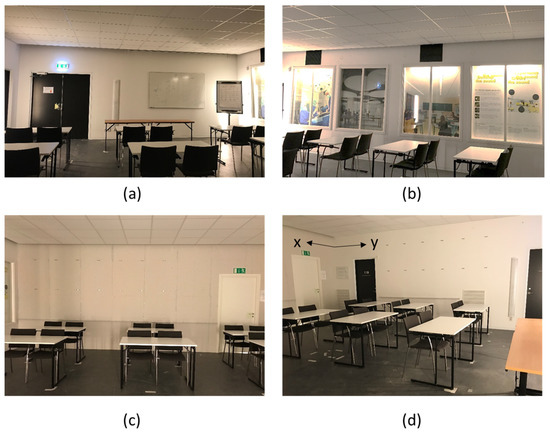
Figure 2.
The classroom with furniture, (a) from the back, (b) from the corner, (c) from the front, (d) from the upper corner, including coordinates for the room.
The room of 55 m2 was furnished with 11 tables and 18 slightly upholstered chairs, but no other furniture. The room was equipped with a whiteboard, a flip board screen and luminaires on the walls (see Figure 2).
2.2. Room Acoustic Parameters and Measurements
The room acoustic parameters evaluated are sound strength (G) Equation (1), speech clarity (C50), Equation (2) and reverberation time (T20). Measurements were performed using the DIRAC system (DIRAC type 7841, v.6.0). G was measured using a constant sound power source placed on the floor. An exponential sweep signal was used as excitation for evaluation of C50 and T20. In the latter, an omnidirectional loudspeaker with dodecahedron geometry was used. The center of the loudspeaker was at 1.55 m from the floor. An omnidirectional microphone was used as a receiver at 1.20 m from the floor. Two source positions and six receiver positions have been used; for positions see Figure 3.
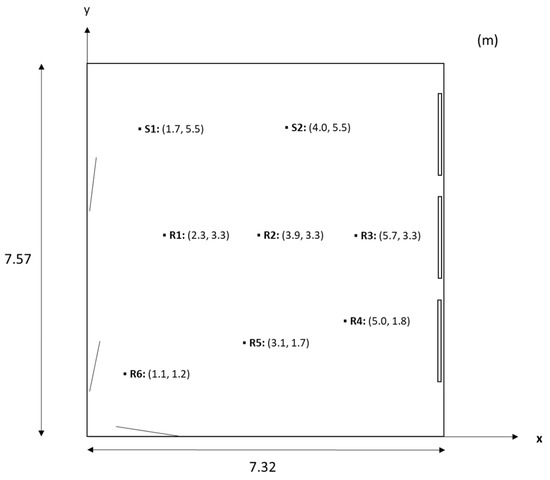
Figure 3.
Room dimensions, source positions S1–S2 and receiver positions R1–R6.
Sound strength G is defined as
Speech clarity C50 is defined as
where h(t) is the impulse response; h10m is the impulse response at 10 m in a free field.
In both speech clarity and sound strength, the early reflections are included. When evaluating T20, according to ISO 3382-2, the evaluation interval is −5 to −25 dB, given that the early reflections are excluded. The evaluation concerns octave bands in range 125–4000 Hz averaged over source and microphone positions.
The measurements were performed over the course of two days, with stable temperature and humidity conditions. It was secured that there was no influence of background noise in the measurements.
2.3. Repeatability Test of Measurement Method
A repeatability test for the measurement procedure used was performed. Impulse response measurements in the classroom mock-up, shown in Figure 2 were repeated five times. The room was furnished and had a suspended absorbent a ceiling. The practical absorption coefficients for the ceiling are shown in Figure 4. Between each measurement, the equipment i.e., the loudspeaker and the microphone, was taken out from the room and reinstalled at different positions. Further, the loudspeaker was rotated, as this too can influence the measurements [37]. The measurement was performed during the course of one day. Temperature and humidity were kept stable during the measurement procedures. However, with regards to the loudspeaker, it was always located at the front of the room in the vicinity of the teacher’s desk. Two loudspeaker positions and six receiver positions for each loudspeaker position were used. Thus, a total of twelve observations were collected for each measurement. The loudspeaker and microphone were always at least one meter from the surrounding walls, and the receiver positions were no less than two meters from the loudspeaker.
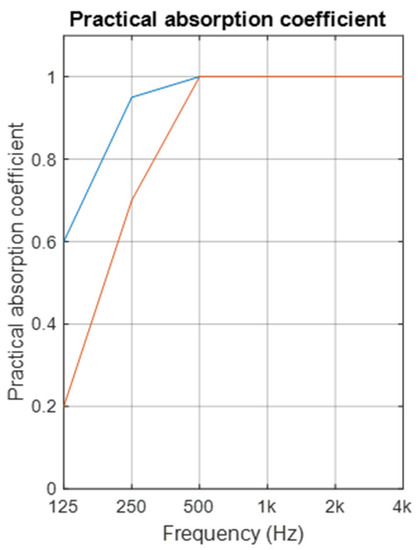
Figure 4.
Absorption coefficient for a 40 mm glass wool product used as absorbing material in the experiments. Blue: Absorption coefficient for overall depth (ODS) 200. Red: ODS 50 mm.
The purpose of the repeatability test was to establish the variation in the averaged room acoustical parameters reverberation time T20, speech clarity C50 and sound strength G, when averaged over the twelve combinations of loudspeaker and receiver positions. Knowing this variation gives an indication of the measurement procedure’s influence when comparing different scenarios of acoustical treatment and the significance of the results. The spatial variation over positions, see Appendix A, are naturally much larger than the variation of the averaged values in the repeatability test. It can, however, be noted that the spatial variation in rooms with ceiling treatment probably differ from what is expected under diffuse field conditions [38].
The repeatability test was performed for the basic configuration, i.e., the classroom with the furniture and ceiling treatment in Figure 4. The results of the five measurements of T20, C50 and G are presented in Table 1. The standard deviation for each pair of possible combinations, i.e., ten different combinations, from the five measurements was calculated and averaged. These results are also shown in Table 1 with the relative standard deviation is presented in the last column. Assuming normal distribution, an approximate uncertainty limit corresponding to a 95% confidence interval is presented in Table 2.

Table 1.
Results of repeatability test of the measurement method used in the study. Average values over the five different measurements, columns 2–6, average for each octave, column 7 and relative standard deviation, column 8.

Table 2.
Uncertainty interval related to repeatability, corresponding to a 95 % confidence interval, for the measurement procedure used in the experiments.
It is concluded that the variations in repeated measurements are less than just noticeable differences (JND), according to ISO 3382-1. This supports the discussion of significant differences in the measurements.
2.4. Acoustic Treatment
2.4.1. Absorbing Material
The absorbing material used in the form of ceiling panels and wall panels is a glass wool product with a thickness of 40 mm and air flow resistivity of 40 kPa*s/m2. The practical absorption coefficient, αp, for the material according to ISO 11654 [39] can be seen in Figure 4 below. The absorption performance is shown for overall depth (ODS) 200 mm, according to specification in standard as well as for ODS of 50 mm, which represents the behavior of the material when mounted directly on the wall. This will be explained in a further section on configurations. The weighted absorption coefficient αw is equal to 1 for both ODS set-ups.
For evaluation of the effect of low frequency absorption, experiments were carried out with added absorption on top of the suspended ceiling. The product used was a 50 mm glass wool product with air flow resistivity of 10 kPa*s/m2 encapsulated in a plastic foil.
2.4.2. Diffusers
The diffusers used were made of a wood frame with a surface of a curved hardboard. All diffusers tested had the same geometry and dimensions 600 mm × 600 mm × 100 mm, see Figure 5. Air gaps on the sides in combination with the enclosed volume gives the diffuser a Helmholtz resonance in the frequency range of 125–250 Hz.
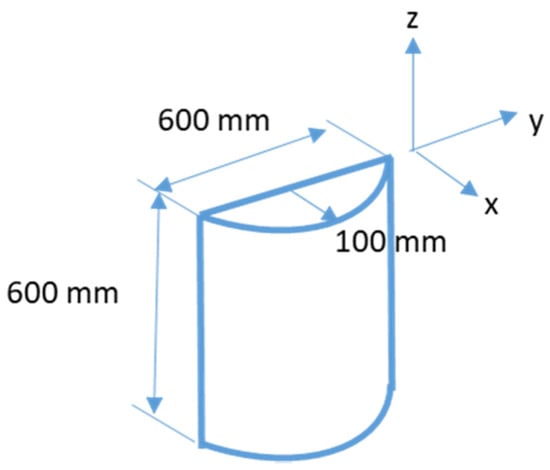
Figure 5.
Sketch of diffuser used in the study, horizontally oriented.
Diffusion characteristics were measured in a semi-anechoic chamber. The energy in the reflections were estimated from impulse responses using windowing techniques, excluding the direct sound. The reflections were measured for azimuthal angles (θ) 0–90 degrees. Figure 6 presents the diffusion characteristics for 500, 2000 and 4000 Hz, and the assumption of symmetrical properties has been applied.
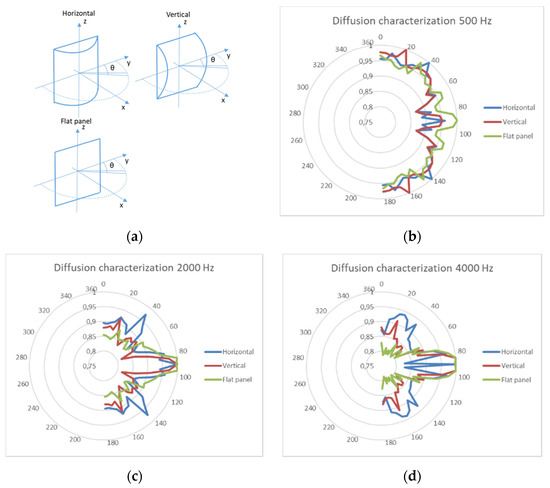
Figure 6.
Diffusion characteristics at (b) 500, (c) 2000 and (d) 4000 Hz. The upper left figure (a) shows the orientation of the diffusers relative room coordinates, see Figure 1.
The diffusers were tested in a vertical and a horizontal direction. In the vertical the majority of sound waves were directed in z-direction, Figure 7. while for horizontal is the majority of waves directed in x-y plane, Figure 8.

Figure 7.
Vertically oriented diffusers, majority of reflections will be sent in z-direction.
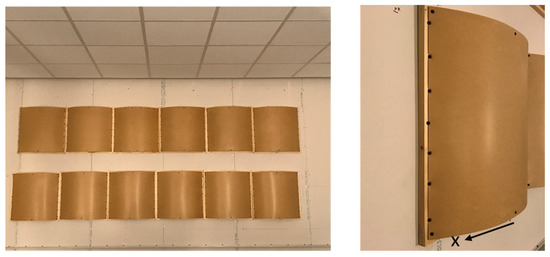
Figure 8.
Horizontally oriented diffusers, majority of reflections will be sent in x-direction.
2.5. Configurations
For this experimental series, nine different configurations were tested, starting from the empty room. Thereafter, there was an absorbent ceiling, with properties according to Section 2.4.1. added and further was the room furnished. From this configuration was different type of wall treatment added, three different configurations: absorbing material, according to Section 2.4.1; vertically oriented diffusers, as in Figure 7; and horizontally oriented diffusers, as in Figure 8. Additional diffusers were installed in the ceiling. These diffusers were located in the front area of the room, i.e., in a typical speaker position. In the last configurations, low frequency absorption was investigated; Helmholtz resonance absorption by diffusers, compared to a porous absorber with properties for good absorption properties in this frequency range (see the last section of Section 2.4.1). All configurations are described in Table 3. For full abbreviations and definitions see Abbreviations.

Table 3.
Configurations in the test series: Configuration number, definition with abbreviations and description of the configurations.
3. Results
The following section is divided into four different subsections, presenting the room acoustic parameters for different configurations. Section 3.1. represents the effect of traditional acoustic treatment and furniture. Section 3.2. includes the effect of acoustic treatment, absorbers and diffusers, on the walls, using the diffusers in different orientations. Section 3.3 describes how the diffusers were placed on the ceiling and Section 3.4. includes the effect of additional low frequency absorption. The results are presented in the form of diagrams, evaluated over octave frequency bands. All values for the room acoustic parameters with the corresponding standard deviation are presented in Appendix A.
3.1. Effect of Absorbent Ceiling and Furniture
The graphs presented in Figure 9 show the room acoustic parameters for a room without treatment (Empty), a room with absorbent ceiling (51.8CA) and a room with absorbent ceiling and furniture (51.8CA_F). For description of furnishing see Section 2.1. Room mock-up. Comparing the empty room with a configuration using acoustic ceiling shows a clear difference for all acoustic parameters over the entire frequency range, with the strongest change from 500 Hz and upwards, which can be correlated to the acoustic performance of the ceiling (see Figure 4). The sound strength in Figure 9a decreases by as much as 8 dB at these frequencies, and speech clarity, in Figure 9b, by 7 dB. The reverberation time, in Figure 9c, decreases to approximately half the value. The reason for the short reverberation times at low frequencies, in an already empty room, is due to the fact that the surrounding walls in the classroom were lightweight walls of plaster board.
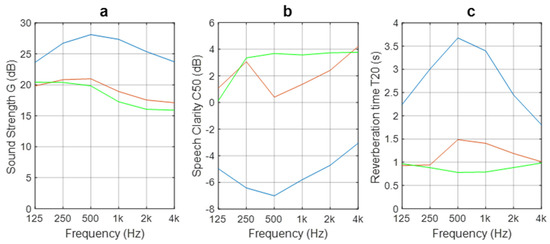
Figure 9.
Room acoustic parameters, (a) sound strength (G), (b) speech clarity (C50) and (c) reverberation time (T20). In blue: room with no treatment (Empty). Red: room with absorbent ceiling (51.8CA). Green: room with absorbent ceiling and furniture (51.8CA_F). Installation of ceiling gives solid differences for the entire frequency range while furniture has highest efficiency at 500–2000 Hz. All parameters are affected by the furniture; thus, the greatest differences are seen for C50 and T20.
Adding furniture contributes by scattering the sound and is effective from 500–2000 Hz, with the largest differences at 500–1000 Hz, resulting in an additional change in curve shapes for the room acoustic parameters. The sound strength value is mainly dependent on the absorption area, but a decrease of about 1 dB for the frequencies 500–4000 Hz can still be found for this parameter, due to scattering and minor absorption from the upholstered chairs. It should be noted that 1 dB is considered a just noticeable difference (JND) for sound strength, according to ISO 3382-1 [24]. The speech clarity and reverberation time is affected in a more limited frequency range, 500–1000 Hz, with significant differences. Regarding speech clarity, an increase of 3 dB is achieved at 500 Hz, and 2 dB at 1000 Hz. As for sound strength, 1 dB difference in speech clarity is considered to be JND, according to [24]. The reverberation time decreased by nearly half at 500 Hz, from 1.5 s to 0.8 s, with less reduction at 1000 Hz and 2000 Hz, although still a noticeable difference, a decrease of 0.6 s at 1000 Hz, and 0.3 s at 2000 Hz. JND for a reverberation time is a change of 5% [24].
Comparing the measured value to calculation with assumption of diffuse sound field using Sabine’s formula shows substantially lower values for calculation over the entire frequency range compared to the measurement, see Figure 10. Note also that the shape of the two curves differs. The slight increase at higher frequencies in the measured curve often appears in sparsely furnished rooms, due to the lateral reflections from walls. The frequency-dependent effect of scattering is not included in the Sabine calculation, but appears as a valley in the measured curve. Measured absorption from furniture is taken into account in the calculation.
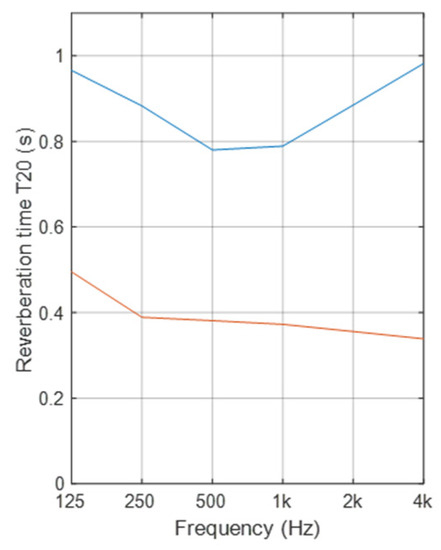
Figure 10.
In blue measured and in red calculated reverberation time for the room with absorbent ceiling and furniture.
3.2. The Effect of Acoustic Treatments on the Walls
The following graphs in Figure 11. present the room acoustic parameters for configurations with acoustic treatment placed on the adjacent walls. Two walls are used, 4.3 m2 is covered with the treatment on each wall for all three configurations presented in this section, i.e., coverage of 8.6 m2 in total. The configurations are with wall absorption (51.8CA_F_8.6WA), vertically oriented wall diffusers (51.8CA_F_8.6VWD) and horizontally oriented wall diffusers (51.8CA_F_8.6HWD) (see Figure 7 and Figure 8). For all configurations in this section, a full covering absorbent ceiling is installed and the room is sparsely furnished, as in configuration 51.8CA_F, which is also included in graphs below for comparison.
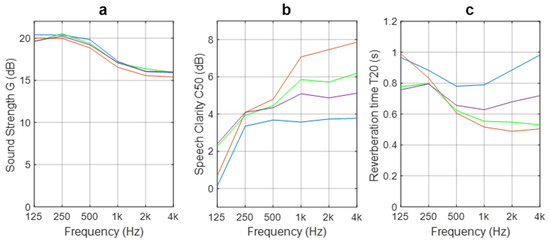
Figure 11.
Room acoustic parameters, (a) sound strength (G), (b) speech clarity (C50) and (c) reverberation time (T20). Blue: base configuration with only ceiling treatment and furniture (51.8CA_F) to be compared with configurations having acoustic treatment on the walls. Red: porous absorbers (51.8CA_F_8.6WA). Green: vertically directed diffusers (51.8CA_F_8.6VWD). Violet: horizontally directed diffusers (51.8CA_F_8.6HWD). The different types of acoustic wall treatment cover the same area in all three cases. The strongest impact on G is achieved with wall absorbers. Diffusers also had a minor effect on this parameter, with similar values obtained independent of orientation. For C50 and T20, the orientation of diffusers is critical, with a greater effect achieved by vertically directed diffusers.
The configuration with wall absorbers results in lower sound strength values in a frequency range of 250 Hz to 4000 Hz, both in comparison with diffuser configurations, as well as with configurations with no wall treatment; a decrease is seen for the entire frequency range in this comparison. The differences are small, but a clear trend is apparent (see the graph in Figure 11). Up to 0.8 dB, lower values are obtained for the configuration with absorbing wall treatment and the diffusing wall treatment within the frequency range of 250–4000 Hz. Thus, G is still lower for configurations with diffusers, compared to no wall treatment (51.8CA_F). Further, a similar G is obtained for configurations with diffuser treatment (51.8CA_F_8.6VWD) and (51.8CA_F_8.6HWD), i.e., the values for this parameter are independent of the direction of diffusers. Note also from this graph, that the lower values in G for configurations with diffusers is at a frequency of 125 Hz. This decrease is not correlated to scattering, but it is due to the resonance absorption for this frequency included in the design of the diffusers used in the study. This is shown further in Section 3.4.
Speech clarity increases for all configurations with any type of wall treatment. The largest increase is seen for configuration with wall absorbers (51.8CA_8.6WA) at a frequency of 500–4000 Hz. In comparison with diffusers, the change is largest at 4000 Hz, with a 1.7 dB and 2.8 dB difference for vertically oriented and horizontally oriented, respectively.
The two configurations with diffusers have similar C50 values in octave bands 125 Hz to 500 Hz, i.e., in the range where these diffusers are not designed to be effective. However, at 1000 Hz to 4000 Hz, clearly higher C50 values are obtained for the vertically oriented diffusers—about 0.8–1.0 dB higher, compared to horizontally oriented diffusers. This is a frequency range where the diffusers are effective, but the vertically oriented diffusers, to a greater degree, distract the lateral sound field and redirect the sound to the absorbent ceiling. The same behavior between the different configurations is seen for reverberation time. In addition to this, for the higher frequencies, similar results are achieved in T20 for configuration with vertical diffusers and wall absorbers. A change in the behavior is obtained for frequency 125 Hz for both C50 and T20 in configurations with diffusers. As for sound strength, this is due to resonance absorption in the diffusers.
3.3. Ceiling Diffusers
The following section presents the effect of diffusers installed in the ceiling. Six of the absorbent panels in the front of the room, typical speaker position, were replaced with diffusers, corresponding to 4.3 m2, see Figure 12. The walls are covered with 8.6 m2 of absorbers and the room is sparsely furnished (47.5CA_4.3CD_F_8.6WA).
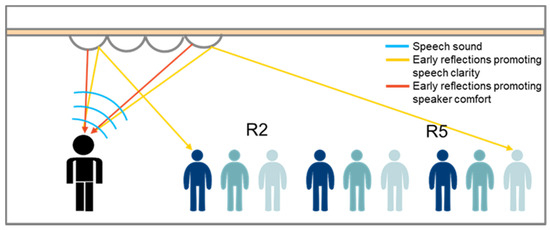
Figure 12.
Location of ceiling diffusers above assumed speaker position. R2 corresponds to position for listener close to the speaker, R5 corresponds to listener in the rear area of the room.
The results for the average values over the twelve measurements show a general decrease in G and T20, and an increase of C50. The difference is small but a clear trend is obtained, see Figure 13. Ceiling diffuser configurations were also tested with no wall treatment or wall diffusers, with equivalent trends being obtained (for the results, see Appendix A).
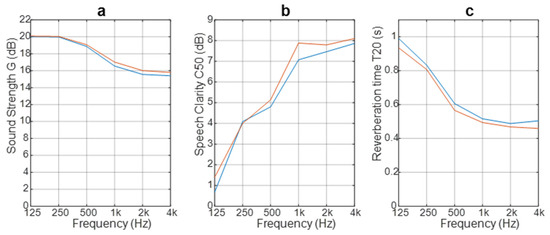
Figure 13.
Global figures, averaged over all source and receiver positions. In (a) sound strength (G), (b) speech clarity (C50) and (c) reverberation time (T20). Blue: room with absorbent ceiling, furniture and wall absorbers (51.8CA_F_8.6WA). Red: room with partly absorbent ceiling, partly ceiling diffusers, furniture and wall absorbers (47.5CA_4.3CD_F_8.6WA). Configuration with ceiling diffusers gives lower value in G, with a clear trend apparent even if the difference is small. In terms of C50 ceiling diffusers give an increase from frequency 500 Hz and upwards, with the greatest difference being 0.8 dB, at 1000 Hz. The reverberation time decreased in configuration with ceiling diffusers over the entire frequency range, with the change being small but the trend clear.
The effect of ceiling diffusers was further evaluated for different positions in the room by comparing the room acoustic parameters for receiver positions R2 and R5, source position S2. Positions are described in Figure 3 and further visualized in Figure 12.
Sound strength decreases with distance from the source, but a comparison to 51.8CA_F_8.6WA show higher values for configuration with ceiling diffusers 47.5CA_4.3CD_F_8.6WA. In addition to the increased energy level, a significant increase is obtained for C50. In R5, i.e., in the back of the room, a difference can be seen for the entire frequency range, with strongest effect at 1000–4000 Hz, an increase of 1.5–3.2 dB. The reverberation time is also affected, mainly in the higher frequency range. Results are shown in Figure 14 and Figure 15.
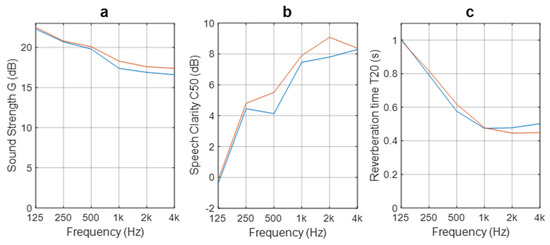
Figure 14.
In (a) sound strength (G), (b) speech clarity (C50) and (c) reverberation time (T20) in position R2. Blue: without ceiling diffusers (51.8CA_F_8.6WA). Red: with ceiling diffusers (47.5CA_4.3CD_F_8.6WA). Small increases in G and C50 are achieved in configurations with diffusers in combinations with slightly lower T20.
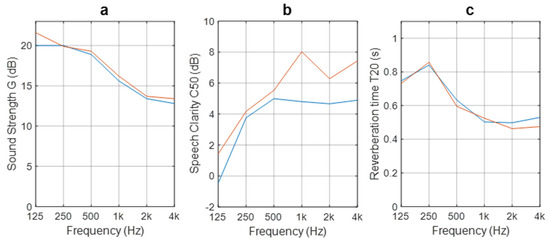
Figure 15.
In (a) sound strength (G), (b) speech clarity (C50) and (c) reverberation time (T20) in position R5, back of the room. Blue: without ceiling diffusers (51.8CA_F_8.6WA). Red: with ceiling diffusers (47.5CA_4.3CD_F_8.6WA). A small increase is seen for G. A significant increase in C50 is achieved with slightly lower T20. The strongest improvements are seen in position R5 and in the frequency range of 1000–4000 Hz.
3.4. Combining Diffusers with Helmholtz Absorption
One way to obtain good absorption in a certain frequency is to use resonance absorbers. The diffusers used in this study were designed to operate as Helmholtz resonator at frequencies 125–250 Hz. The result of its effect in configuration 51.8CA_F_8.6VWD is compared with configuration with a porous low frequency absorber, configuration 51.8CA_25.0LFMA, described in Section 2.4.1. Evaluation of reverberation time shows a clear effect for both configurations at low frequencies. It could be noted that 8.6 m2 diffusers were used while the area of porous low frequency absorber was 25 m2. Additionally, the diffusers affect the higher frequency range to a greater extent. The results are presented in Figure 16.
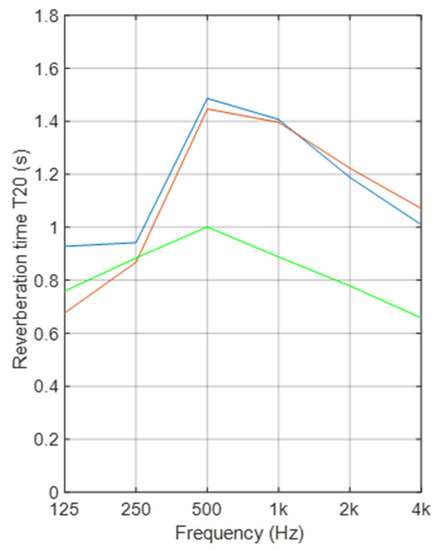
Figure 16.
Reverberation time (T20), in blue only absorbent ceiling (51.8CA), in green vertical wall diffusers (51.8CA_8.6VWD) and in red low frequency porous absorber (51.8CA_25.0LFMA). The two latter configurations affect the lower frequencies significantly; thus, the areas used for the different low frequency treatments are different. In addition, the diffusers affect the higher frequency range to a greater extent.
4. Discussion
Installing the fully covering absorbent ceiling in the empty room, as a first step, affected all the room acoustic parameters. This treatment can be seen as a good baseline for a classroom, since it significantly decreases the sound strength and reverberation time, and increases the speech clarity. The addition of furniture also affected the results, mainly due to increased scattering, as only a small amount of absorption is involved. The furniture affects the parameters particularly at frequencies of 500–1000 Hz. This configuration, an absorbent ceiling and a sparsely furnished room, could be seen as a normal classroom situation. It is important to note the difference in result between measurement and calculated T20 by using diffuse sound field theory for this configuration. The much lower values achieved in calculation demonstrate that the lateral sound field must be considered in acoustic models dealing with ordinary, furnished rooms.
The additional acoustic treatment in different configurations using absorbers and diffusers contributed important effects for fine-tuning the acoustics. The general finding was that higher sound energy levels were obtained for configurations with diffusers, and lower energy levels for configurations with absorbers. Both types of treatment affected speech clarity and reverberation time.
With the diffusers, the energy is conserved, compared to the absorbers where the energy is reduced, explaining why both horizontally oriented and vertically oriented diffusers have similar values in terms of sound strength. A reason for the effect on speech clarity and reverberation time is the scattering of the diffusers. Significant differences are found between the vertically and horizontally directing diffusers, where the vertical affected C50 and T20 to a greater extent. The vertically oriented diffusers reduced the sound waves in the horizontal plane and directed the sound into the ceiling, showing the importance of directional scattering in rooms with ceiling treatment, which correlates well to the diffusion characteristics of the diffusing elements.
In the experiments using diffusers in the ceiling, important improvements for receivers located outside the direct sound field could be achieved. Keeping the sound energy level, a significant increase in speech clarity was found for the receiver at the back. This is an important application for use in classrooms where a teacher gives instructions at the front of the room. An interesting finding with all the ceiling diffuser configurations was that a decrease in T20 was obtained while G increased, and this finding also applied when evaluating the results on an average basis for the twelve different measurements. This raises, again, the question of the importance of considering the effect of scattering.
It should be observed that C50 only gives information about the early-to-late ratio of the reflections, and does not explain anything about the sound energy. This means that high C50 can be achieved without guaranteeing sound energy will be sufficiently high for the listener, or supporting the speaker. A case with high C50 and low sound energy can result in:
- (1)
- Too low a sound level reaching listeners in the rear area of the classroom;
- (2)
- Greater voice effort for the speaker.
In the configurations with diffusers, an increase in C50 could retain the sound strength, i.e., the sound energy.
In choosing the acoustic treatment, it is important to consider the type of room acoustic properties required for the specific room. With diffusers, reverberation time can be lowered and the ratio of early reflections increase with sound energy conserved. Thus, for environments where complex tasks requiring concentration are performed or in a very noisy environment, sound energy reducing treatment should be used. It is thus of importance to define the activity taking place in the room when choosing the acoustic treatment.
In the discussion of acoustic design, it is important to note that the diffusers used in this study were designed to operate as scattering objects for the higher frequency range, which is important for speech, and for absorption at low frequencies. It is possible to design the diffusers to operate at the requested frequencies.
It has been mentioned above that only small effects were seen for some configurations. It should be noted that only a small part of the wall area was covered, for example, the ceiling diffusers covered 8% of the ceiling area. An increased area of acoustic treatment would, to a certain degree, affect the values further. However, realistic conditions must be considered, e.g., a real classroom can have more furniture affecting the scattering properties. Other factors that can influence the perception of the acoustics, not studied in this investigation, are background noise, the people and their activities.
An observation from the results is the importance of using several room acoustic parameters to characterize a specific acoustic environment (see e.g., Figure 15). For example, T20 and C50 can be varied with diffusers, but still maintain the sound strength. However, using absorbers, the sound strength can be varied as well. The outcome of these two scenarios will be different experienced, and needs to be considered to obtain the correct acoustic balance for low and high frequencies in ordinary public rooms.
5. Conclusions
A clear trend in how different types of acoustic treatment affect room acoustic parameters has been demonstrated where, as a baseline, an acoustic ceiling should be used to decrease the energy level, increase the ratio of early-to-late reflections and lower the reverberation time. However, in a sparsely furnished room, it can still be difficult to achieve a high-quality sound environment with only an absorbent ceiling. The room acoustic parameters can be fine-tuned by using diffusers and absorbers on the walls and/or in the ceiling. The two different types of treatment operate differently and create distinctive experiences for the people in the room. With additional porous absorbers, G and T20 are decreased and C50 is increased, while diffusers affect C50 and T20, keeping G stable or increased, depending on placement and amount.
The diffusers used in this study where efficient in absorbing sound at the frequency of 125–250 Hz, but the frequency range within which it operates as a resonant absorber can easily be adopted. Additionally, the frequency ranges for which it operated most efficiently as a scattering object can be adjusted, depending on the demands.
This study provides information on how different acoustic treatments can be used to obtain different room acoustic qualities, and can be used to improve the sound environment in ordinary public rooms. However, the target values of the room acoustic parameters must be defined for the specific environment and activity, in order to use this information for correct the fine-tuning of acoustic environments.
6. Patents
Patent pending, European Patent Office, 20170667.8.
Author Contributions
Writing—original draft preparation: E.A.; Writing—significant contribution to introduction paragraph: E.N.; Experiments—design and accomplishment: E.A. and E.N.; Experiments—analysis: E.A.; Writing—editing and review: E.A.; Structure of paper and supervision: E.N., O.J.I.K. and D.B.H. All authors read and agreed to the published version of the manuscript.
Funding
This research is funded by Saint-Gobain Ecophon.
Acknowledgments
The authors are grateful for the support from Ecophon providing material, laboratory equipment and laboratory facilities making it possible to perform the experiments.
Conflicts of Interest
The authors declare no conflict of interest.
Abbreviations
| Acoustic Configurations | |
| CA | Ceiling absorptive |
| CD | Ceiling diffuser |
| F | Furniture, the room is sparsely furnished |
| WA | Wall absorbers |
| VWD | Vertical wall diffusers |
| HWD | Horizontal wall diffusers |
| LFMA | Low frequency mineral wool absorber |
Appendix A

Table A1.
Number together with any of above written abbreviations describes the m2 of the specified acoustic treatment.
Table A1.
Number together with any of above written abbreviations describes the m2 of the specified acoustic treatment.
| Acoustic Parameters | |
|---|---|
| G | Sound Strength |
| C50 | Speech Clarity |
| T20 | Reverberation time, evaluated over 20 dB decrease |
References
- Astolfi, A.; Pellerey, F. Subjective and objective assessment of acoustical and overall environmental quality in secondary school classrooms. J. Acoust. Soc. Am. 2008, 123, 163–173. [Google Scholar] [CrossRef] [PubMed]
- Shield, B.; Conetta, R.; Dockrell, J.; Connolly, D.; Cox, T.; Mydlarz, C. A survey of acoustic conditions and noise levels in secondary school classrooms in England. J. Acoust. Soc. Am. 2015, 137, 177–188. [Google Scholar] [CrossRef] [PubMed]
- Ljung, R.; Israelsson, K.; Hygge, S. Speech intelligibility and recall of spoken material heard at different signal-to-noise ratios and the role played by working memory capacity. Appl. Cogn. Psychol. 2013, 27, 198–203. [Google Scholar] [CrossRef]
- Shield, B.M.; Dockrell, J.E. The effects of environmental and classroom noise on the academic attainments of primary school children. J. Acoust. Soc. Am. 2008, 123, 133–144. [Google Scholar] [CrossRef]
- Åhlander, V.L.; Rydell, R.; Löfqvist, A. Speaker’s comfort in teaching environments: Voice problems in Swedish teaching staff. J. Voice 2011, 25, 430–440. [Google Scholar] [CrossRef]
- Pelegrín-García, D.; Brunskog, J. Speakers’ comfort and voice level variation in classrooms: Laboratory research. J. Acoust. Soc. Am. 2012, 132, 249–260. [Google Scholar] [CrossRef]
- Brunskog, J.; Gade, A.; Bellester, G.; Calbo, L. Increase in voice level and speaker comfort in lecture rooms. J. Acoust. Soc. Am. 2009, 125, 2072–2082. [Google Scholar] [CrossRef]
- Pelegrin-Garcia, D.; Brunskog, J.; Lyberg-Åhlander, V.; Löfqvist, A. Measurement and prediction of voice support and room gain in school classrooms. J. Acoust. Soc. Am. 2012, 13, 194–204. [Google Scholar] [CrossRef]
- Rasmussen, B.; Brunskog, J.; Hoffmeyer, D. Reverberation time in class rooms–Comparison of regulations and classification criteria in the Nordic countries. In Proceedings of the Joint Baltic-Nordic Acoustic Meeting, Odense, Denmark, 18 June 2012. [Google Scholar]
- ISO 3382-2. Acoustics-Measurement of Room Acousitc Parameters-Part. 2: Reverberation Time in Ordinary Rooms; International Organization for Standardization: Brussels, Belgium, 2008. [Google Scholar]
- Cremer, L.; Müller, A.; Schultz, T. Principles and applications of room acosutics. Appl. Sci. Publ. 1982, 1, 413. [Google Scholar]
- Kuttruff, H. Room Acoustics; CRC Press: Boca Raton, FL, USA, 2017; p. 174. [Google Scholar]
- Nilsson, E. Decay processes in rooms with non-diffuse sound fields. Part 1: Ceiling treatment with absorbing material. J. Build. Acosutics 2004, 11, 39–60. [Google Scholar] [CrossRef]
- Lochner, J.; Burger, F. The influence of reflections on auditorium acoustics. J. Sound Vib. 1964, 4, 426–454. [Google Scholar] [CrossRef]
- Sato, J.; Bradley, J. Evaluation of acoustical conditions for speech communication in working elementary school classrooms. J. Acoust. Soc. Am. 2008, 4, 2064–2077. [Google Scholar] [CrossRef] [PubMed]
- Sato, H.; Morimoto, M.; Sato, H.; Wada, M. Relationship between listening difficulty and acoustical objective measures in reverberant fields. J. Acoust. Soc. Am. 2008, 4, 2087–2093. [Google Scholar] [CrossRef] [PubMed]
- Sato, H.; Morimoto, M.; Wada, M. Relationship between listening difficulty rating and objective measures in reverberant and noisy sound fields for young adults and elderly persons. J. Acoust. Soc. Am. 2012, 6, 4596–4605. [Google Scholar] [CrossRef]
- Sato, H.; Bradley, J.; Morimoto, M. Using listening difficulty ratings of conditions for speech communication in rooms. J. Acoust. Soc. Am. 2005, 3, 1157–1167. [Google Scholar]
- Yang, W.; Bradley, J. Effects of room acoustics on the intelligibility of speech in classrooms for young children. J. Acoust. Soc. Am. 2009, 2, 922–933. [Google Scholar] [CrossRef]
- Nijs, L.; Rychtarikova, M. Calculating the optimum reverberation time and absorption coefficient for good speech intelligibility in classroom design using U50. Acta Acoust. United Acoust. 2011, 1, 93–102. [Google Scholar] [CrossRef]
- Astolfi, A.; Parati, L.; D’Orazio, D.; Garai, M. The New Italian standard UNI 11532 on acoustics for schools. In International Congress on Acoustics; ICA: Aachen, Germany, 2019. [Google Scholar]
- NS. 8175:2019, Lydforhold I Bygninger Lydklasser for Ulike Bygningstyper; Norwegian Standard: Utrecht, The Netherlands, 2019. [Google Scholar]
- IEC. 60268-16: Sound System Equipment. Part. 16, ObJ.ective Rating of Speech Intelligibility by Speech Transmission Index, 2011–06; IEC: Geneva, Switzerland, 2011. [Google Scholar]
- EN. ISO 3382-1: Acoustics-Measurement of Room Acoustic Parameters-Part. 1: Performance Spaces; Norwegian Standard: Utrecht, The Netherlands, 2009. [Google Scholar]
- Puglisi, G.E.; Prato, A.; Sacco, T.; Astolfi, A. Influence of classroom acoustics on the reading speed: A case study on Italian second-graders. J. Acoust. Soc. Am. 2018, 144, 2. [Google Scholar] [CrossRef]
- Bradley, J.S.; Reich, R.; Norcross, S. On the combined effects of signal-to-noise ratio and room acoustics on speech intelligibility. J. Acoust. Soc. Am. 1999, 106, 1820–1880. [Google Scholar] [CrossRef]
- Bradley, J.S.; Sato, H.; Picard, M. On the importance of early reflections for speech in rooms. J. Acoust. Soc. Am. 2003, 6, 3233–3244. [Google Scholar] [CrossRef]
- Barron, M.; Lee, L.-J. Energy relations in concert auditoriums. J. Acoust. Soc. Am. 1988, 2, 618–628. [Google Scholar] [CrossRef]
- Barron, M. Theory and measurement of early, late and total sound levels in rooms. J. Acoust. Soc. Am. 2015, 6, 3087–3098. [Google Scholar] [CrossRef]
- Nilsson, E. Decay Processes in Room with Non-Diffuse Sound Fields. Part II: Effect of Irregularities. Build. Acoust. 2004, 11, 133–143. [Google Scholar] [CrossRef]
- Cox, T.; D’Antonio, P. Acoustic Absorbers and Diffusers, 3rd ed.; CRC Press: Boca Raton, FL, USA, 2017. [Google Scholar]
- Cucharero, J.; Hänninen, T.; Lokki, T. Influence of sound-absorbing material placement on room acoustical parameters. In Acoustics; Multidisciplinary Digital Publishing Institute: Basel, Switzerland, 2019. [Google Scholar]
- Berardi, U.; Iannace, G.; Trematerra, A. Acoustic treatments aiming to achieve the italian minimum environmental criteria (cam) standards in large reverberant classrooms. Can. Acoust. 2019, 47, 1. [Google Scholar]
- Choi, Y.-J. An Optimum Combination of Absorptive and Diffusing Treatments for Classroom Acosutic Design. Build. Acoust. 2014, 2, 175–180. [Google Scholar] [CrossRef]
- Choi, Y.-J. The application of diffusers for classroom acoustical design. Noise Vib. Worldw. 2014, 45, 5. [Google Scholar]
- Nilsson, E.; Hammer, P. Subjective evaluation of speech intelligibility for normal-hearing persons and for persons with simulated minimal degrees of hearing-loss. In INTER-NOISE and NOISE-CON Congress and Conference Proceedings; Institute of Noise Control Engineering: Reston, VA, USA, 1995. [Google Scholar]
- Knüttel, T.; Vorländer, M.; Witew, I.B. Influence of omnidirectional loudspeaker directivity on measured room impulse responses. J. Acoust. Soc. Am. 2013, 5, 3654–3662. [Google Scholar] [CrossRef]
- Vigran, T. Building Acoustics; Taylor and Francis: London, UK, 2008; p. 452. [Google Scholar]
- SS-EN ISO. 11654:1997, Byggakustik-LJ.udabsorbenter-Värdering av Mätresultat Och Klassindelning; ISO: Geneva, Switzerland, 1997. [Google Scholar]
© 2020 by the authors. Licensee MDPI, Basel, Switzerland. This article is an open access article distributed under the terms and conditions of the Creative Commons Attribution (CC BY) license (http://creativecommons.org/licenses/by/4.0/).